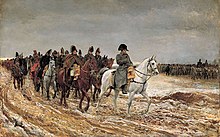Battle of Laon
| Battle of Laon | |||||||
|---|---|---|---|---|---|---|---|
| Part of the War of the Sixth Coalition | |||||||
 Napoleon and his staff are returning from Soissons after the battle of Laon. |
|||||||
|
|||||||
| Belligerents | |||||||
|
|
|
||||||
| Commanders and leaders | |||||||
|
|
|
||||||
| Strength | |||||||
| 37,000 | 90,000 | ||||||
| Casualties and losses | |||||||
| 6,500 | 4,000 | ||||||
The Battle of Laon (9–10 March 1814) was the victory of Blücher's Prussian army over Napoleon's French army near Laon.
An Allied coalition attempted to complete the destruction of Napoleon's French Empire in 1814. France had been defeated in Russia in 1812 and in Central Europe in 1813. Napoleon's French Empire was now fighting for its survival.
In the last week of February 1814, about a month after the start of the Allied invasion, Blücher seized the initiative and advanced on Paris with his forces. Napoleon's two marshals in the immediate vicinity, Édouard Mortier and Auguste Marmont, were covering the city with two detached corps, but they only had 10,000 men and would be unable to hold out against Blücher's larger force. Napoleon hurried westwards to their rescue with around 30,000 troops, hoping to trap Blücher against the Marne river.
Blücher unsuccessfully attacked Marmont and Mortier along the Ourcq river in late February and early March and ordered a retreat north to regroup when he heard of Napoleon's advance. Prussian troops crossed the swollen Aisne river and arrived at Soissons on 4 March. There they linked up with reinforcements that brought Blücher's total force to 100,000. On 7 March, a clash ensued at the Battle of Craonne as Napoleon attacked westwards along the Chemin des Dames (literally, the "ladies' path"). Blücher's outflanking maneuver did not materialize in time and the Prussians were forced to withdraw towards Laon.
Blücher chose to fight at Laon because it was an important road junction with a superb defensive position. Laon was located on a flat-topped hill with steep slopes that rose 330 feet above the surrounding area. The countryside to the north was flat and open, but the south contained rough and wooded terrain that made military maneuvers difficult. The villages of Ardon and Semilly at the foot of the hill served as good bastions for the Prussian and Russian forces.
...
Wikipedia
